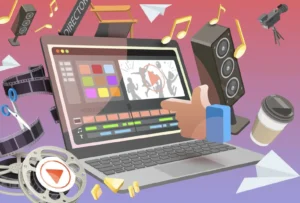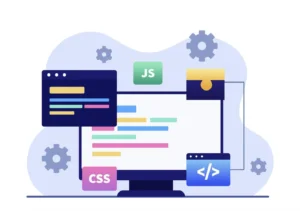What Is Cutting-Edge Technology?
Cutting-edge technology means tools or systems that are very new and powerful. These are not old machines or outdated apps. These are the tools experts use today to solve big problems or make things faster, smarter, or easier.
Examples include:
- A smartwatch that tracks your sleep using sensors and machine learning.
- Voice assistants like Siri that understand and respond to speech.
- A drone that flies and takes photos using GPS and automation.
These tools are already helping in homes, hospitals, schools, and factories.
Artificial Intelligence (AI) in Everyday Life
AI is when computers do tasks that usually need human thinking. It can:
- Recognize your face to unlock your phone.
- Suggest songs you might like.
- Help doctors spot illness in X-rays.
Expert tip: AI improves by learning from data. That’s why apps often ask for access to your camera or location — to learn better.
In one of my past jobs, I helped build a customer support chatbot. At first, it didn’t answer well. But after feeding it real conversations, it became much smarter and helped more people.
Machine Learning in Action
Machine learning is a part of AI that teaches itself by finding patterns in data. It’s behind many things you see every day:
- Email filters that send junk mail to spam.
- Maps that update your route based on traffic.
- Video platforms suggesting what to watch next.
How it works:
- It watches what you do.
- It finds habits or choices.
- It makes predictions based on that.
Machine learning is powerful but needs clean, fair data to work well.
Internet of Things (IoT) at Home and Work
IoT refers to smart devices connected to the internet that share data with each other.
At home:
- Smart bulbs that turn on automatically.
- Fridges that remind you when you’re low on food.
- Cameras that send alerts when they detect movement.
At work:
- Sensors in factories to control temperature.
- Trackers on delivery trucks to follow routes.
- Smart shelves that know when products are gone.
In one bakery I worked with, we installed temperature sensors in their freezers. Now if a freezer gets too warm, they get a text right away and can fix it before losing food.
Blockchain Beyond Cryptocurrency
Blockchain is like a digital notebook that many people can read but no one can erase or change secretly.
It’s used for:
- Sending money safely without banks.
- Tracking how food or goods move through factories.
- Creating digital contracts that run on their own.
Benefits include:
- Everyone sees the same version.
- It’s hard to hack or fake.
- Things happen automatically with no delay.
Experts are also using it to improve voting systems and protect health records.
Augmented Reality (AR) in Daily Use
AR adds digital images to the real world around you.
Uses:
- Apps that let you see how furniture fits in your room.
- Games that show characters in your yard.
- Windshields that show maps and speed while driving.
It helps:
- Shoppers try things before buying.
- Students understand hard topics better.
- Workers learn jobs without real risk.
I once used an AR app to see how a sofa would look in my living room. It saved me from buying one that wouldn’t fit.
Virtual Reality (VR) in Training and Fun
VR puts you inside a new, fully digital world. You wear goggles and see things like you’re really there.
Common uses:
- Games that let you explore space or cities.
- Job training for firefighters or doctors.
- Online learning that feels like a real classroom.
VR needs fast internet and powerful devices, but it’s becoming easier to use every year.
Robotics Helping Humans
Robots are machines that move and do jobs, often without help.
Examples:
- Robots that build cars in factories.
- Machines that help with surgeries in hospitals.
- Delivery robots that bring food in hotels.
Robots are also used to:
- Clean rooms using UV light.
- Pack boxes in big warehouses.
- Help people walk with robotic legs.
Good robots are not just strong. They are smart enough to avoid mistakes and work safely with people.
5G Networks and What They Do
5G is a fast type of wireless internet. It’s much quicker than 4G and responds almost instantly.
Why 5G matters:
- You can download a movie in seconds.
- Self-driving cars can talk to each other to avoid crashes.
- Doctors can control tools far away in real-time.
It also helps connect many devices at once, which is useful in busy places like stadiums or smart homes.
Quantum Computing and Why It Matters
Quantum computers are machines that solve very hard problems regular computers can’t.
They help with:
- Weather forecasts that are more accurate.
- Finding new treatments for diseases.
- Protecting information from hackers.
Quantum computers use something called qubits. These are different from regular bits and can do many tasks at once.
This field is still growing, but it will likely change many industries in the next decade.
Biometric Tech in Security
Biometrics uses your body — like your face, eyes, or fingerprints — to unlock things.
Common uses:
- Phones that unlock with your face.
- Airports using fingerprints to check identity.
- Offices using eye scans for entry.
Why it’s helpful:
- You don’t need to remember a password.
- It’s fast and easy.
- It’s harder to fake.
But if someone steals this data, it’s not easy to change like a password. So security must be handled with care.
Edge Computing and Real-Time Data
Edge computing means processing data near the source instead of sending it far away to the cloud.
Why it’s useful:
- Smart traffic systems can respond quickly to traffic flow.
- Farms can adjust watering based on live soil readings.
- Machines can detect problems and fix themselves before breaking.
It saves time, reduces internet use, and helps systems work smoothly in real-time.
Nanotechnology in Medicine
Nanotech is about working with tiny things — smaller than cells.
Doctors use it for:
- Sending medicine directly to sick parts of the body.
- Catching diseases before you feel sick.
- Healing burns and wounds faster.
Some hospitals already use sprays with nanotech to heal skin. These tiny tools work at levels too small for human eyes to see.
Smart Wearables: More Than Just Watches
Wearables are tech devices you wear on your body.
Examples:
- Watches that track your heart rate and steps.
- Glasses that show helpful information.
- Shoes that guide you by vibrating gently.
They are also used in health and safety:
- Doctors use them to track patient health remotely.
- Factories use them to warn workers of fatigue.
- Parents use them to keep track of children.
These devices are small, helpful, and growing smarter every year.
Tips to Stay Updated with Technology
- Read blogs or simple tech news weekly.
- Watch trusted YouTube channels for hands-on reviews.
- Visit stores to test gadgets yourself.
- Follow big tech companies for updates.
- Try free beginner courses on coding or smart tech.
Here is a References Links Below:
Applications of new technology – part 1
Space Technology Applications in Science and Industry







